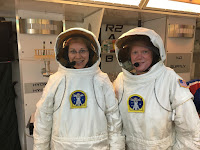 |
| Space Camp Graduation Night |
The day before I left for Space Camp, which was four days before the end of my students' school year, a fellow teacher and good friend of mine was expressing her excitement for my impending trip. She said, "It's like you won Double Dare!" Immediately I was transported back to those junior high days of watching game shows on Nickelodeon and seeing the ads for Space Camp, which the winners would indeed get to attend. I am here to tell you, it lived up to the hype of the ads, and I didn't even have to get slimed to attend!
I attended with 100 other teachers from around the world. Two of the free t-shirts proclaim there were 25 countries and 37 states represented at HESA, but Honeywell sends 200 teachers over two weeks to Space Camp, so it's likely there weren't all 25 countries and 37 states represented while I was in Alabama. Even so, there were six countries represented in my small group of 14, Team Columbus. We had three Vietnamese teachers, one Russian, one Canadian, one Mexican, one Indonesian, and seven Americans. Team Columbus was one of the best parts of the entire experience. About half of us sat up late together every night in the dorm talking about life and teaching. We started a shared folder on Google Drive to share teaching resources and a Facebook group to keep in touch.
 |
| Team Columbus with Space Camp Founder Ed Buckbee |
 |
| Making a Super Ball |
Of course, the international professional collaboration will be the longest lasting impact of the entire Space Camp experience, but participating in the missions, simulations, and hands on activities, and getting special presentations at the U.S. Space and Rocket Center was incredibly cool... I am itching to try new ways of teaching my unit on The Properties of Matter and can't wait to show off my pictures and videos to my students. I know I will be able to engage them in a discussion of the properties of liquids and solids when we make super balls out of two liquids that then solidify - an experiment I got to perform as a scientist during our simulated missions.
 |
| Suited up for our EVA |
 |
| Preparing to Dock with Orion |
After two summers in a row where I was able to seize the opportunity to go on "teacher field trips" for professional development purposes, I can't ever imagine signing up for regular classes again simply to earn continuing education credit. Space Camp and the DIG Field School last summer opened my eyes to a better, more engaging, hands on way to continue to develop my passion and excitement for teaching, meet other teachers who are excited to keep in touch and collaborate, and earn CEs that will allow me to renew my certification. I just have to continue to seek out these opportunities and apply for them!
 |
| Summer 2015 at the DIG Field School |
No comments:
Post a Comment